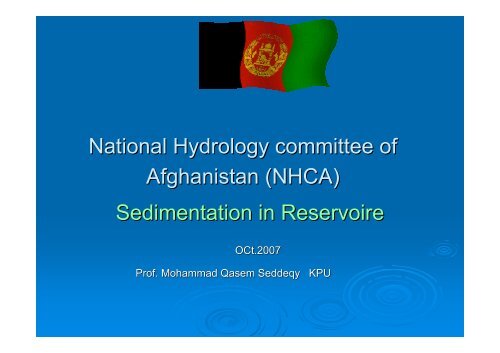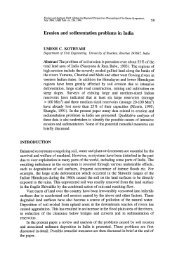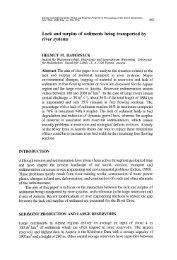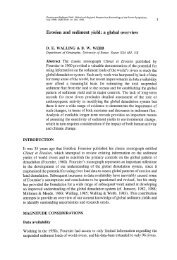National Hydrology committee of Afghanistan (NHCA ...
National Hydrology committee of Afghanistan (NHCA ...
National Hydrology committee of Afghanistan (NHCA ...
Create successful ePaper yourself
Turn your PDF publications into a flip-book with our unique Google optimized e-Paper software.
<strong>National</strong> <strong>Hydrology</strong> <strong>committee</strong> <strong>of</strong><br />
<strong>Afghanistan</strong> (<strong>NHCA</strong>)<br />
Sedimentation in Reservoire<br />
OCt.2007<br />
Pr<strong>of</strong>. Mohammad Qasem Seddeqy<br />
KPU
بسم االله الرحمن الرحيم<br />
وجعلنامن الماءکل شئء حی<br />
30<br />
واز آب هر چيزی رازنده گردانيدیم سوره انبيا ایه
Classification <strong>of</strong> Rivers according to<br />
the topography <strong>of</strong> the river basin<br />
‣ Upper reaches in the hilly region<br />
‣ Lower reaches in the alluvial plain<br />
Rivers on alluvial plains may be broadly classified in<br />
to three types:<br />
1. The meandering type<br />
2. The aggrading type<br />
3. The degrading type
Sediment is fragmental material,<br />
primarily formed by the physical<br />
and chemical disintegration <strong>of</strong><br />
rocks from the earth crust.<br />
The process <strong>of</strong> moving and<br />
removing from their original<br />
source or resting place is called<br />
erosion
Why a good understanding <strong>of</strong> sediment<br />
transport processes is indispensable<br />
1. Morphological boundary condition for<br />
design <strong>of</strong> Hydraulic structure and river<br />
training works<br />
2. Sedimentation in reservoirs<br />
3. Sediment problems at Intakes<br />
4. Environmental Impact assessment
Origin and types <strong>of</strong> Sediment<br />
‣ Cohesive<br />
‣ Non Cohesive<br />
Cohesive sediment – the physical- chemical<br />
interaction between particles plays a<br />
significant role.<br />
Non Cohesive sediment – there is no<br />
physical and chemical interaction between<br />
individual particles .
Sediment Control Plan<br />
Q<br />
Control Point<br />
(Q+A-B)*α<br />
B<br />
A<br />
E<br />
C<br />
D<br />
Target Area<br />
‣ E=(Q+A - B)(1 -α) - C - D
Sediment Control Plan<br />
‣ E=(Q+A - B)(1 -α) - C - D<br />
• E : Design allowable sediment discharge<br />
• Q : Design sediment discharge at the design<br />
control point <strong>of</strong> the upstream end <strong>of</strong> the<br />
subject sub-basin<br />
basin<br />
• A : Design sediment production<br />
• B : Design reduction <strong>of</strong> sediment production<br />
• α : Ratio <strong>of</strong> volume <strong>of</strong> channel sediment<br />
mitigation<br />
• C : Design reduction <strong>of</strong> sediment discharge<br />
• D : Design mitigation volume <strong>of</strong> sediment<br />
discharge
Sediment Control Dam<br />
‣ Function 1: To Stabilize<br />
Hillside Slopes<br />
Scouring force<br />
becomes less than<br />
before;<br />
Shallower in depth,<br />
Slower in velocity
Sediment Control Dam<br />
‣ Function 1 To Reduce Sediment<br />
Discharge<br />
Sediment Capacity<br />
for Flood Period<br />
Initial Sediment<br />
Capacity
Sediment Control Dam<br />
‣ Function 2: To Mitigate Streambed<br />
Erosion by milder bed-slope with<br />
Stepwise Dams<br />
L<br />
h<br />
m<br />
n<br />
1<br />
1<br />
m>n<br />
L=((m*n)/(m - n))*h
Sediment Control Dam<br />
‣ Function 3: To Mitigate Sediment<br />
Run<strong>of</strong>f<br />
Design Sedimentation Line<br />
to Cover the Unstable<br />
Sediment Deposition<br />
Unstable Sediment<br />
Deposition
3D VIEW OF KABUL RIVER BASIN<br />
Kabul<br />
Naghlu<br />
dam<br />
Oulet basin
3D View <strong>of</strong> Alingar River<br />
Basin<br />
Darunta<br />
Dam
Other view from agriculture land <strong>of</strong><br />
Gulbahar –Panjsheer desert
3D view <strong>of</strong> Sorobi and Naglu<br />
dams<br />
Naghlu dam<br />
Sorobi<br />
dam
3D View <strong>of</strong> from Kunar River<br />
Kunar river<br />
Pakistan<br />
Darunta<br />
dam
3D View <strong>of</strong> Darunta Dam<br />
2002-09-<br />
Darunta<br />
dam<br />
: Date<br />
Landsat 7 satalite<br />
22
3D View <strong>of</strong> Panjsheer river<br />
Basin<br />
Gulbahar<br />
desert<br />
Naghlu<br />
dam<br />
Darunta<br />
dam
Darunta Reservoir 24<br />
years ago<br />
1979-06-<br />
: Date Landsat 3 satalite<br />
20
•Sedimentation<br />
‣ Intensive soil erosion has been causing<br />
rapid sedimentation <strong>of</strong> reservoirs with<br />
an important loss <strong>of</strong> irrigation lands,<br />
power generation capacity and life time<br />
<strong>of</strong> reservoirs<br />
‣ Afganistan is facing annually with 150<br />
million m3 sedimentation in the<br />
reservoirs and 400 million m3<br />
sedimentation to downstream <strong>of</strong> dam<br />
reservoirs and irrigation networks
Causes <strong>of</strong> sedimentation<br />
‣ Desertification<br />
1. Continued deforestation from logging and fuel wood needs : In<br />
South,east and northeast <strong>of</strong> <strong>Afghanistan</strong>.<br />
2. overgrazing:The grazing lands used by Kochis (nomads)have<br />
been dried out due to the lack <strong>of</strong> sufficient rainfalls & converting to<br />
cultivable land causing considerable reduction in livestock and<br />
livelihood.<br />
3. Destroying land covers bush used for fuel wood<br />
4. Soil erosion due to flood and wind<br />
5. Unsustainable agriculture :Salinization:<br />
<strong>of</strong> soil ,over use <strong>of</strong><br />
agricultural inputs.<br />
6. Drought :Started in 1969,getting up to a critical status in 1997-<br />
2002 ,causing hydrological circulations <strong>of</strong> the soil
‣ Lack <strong>of</strong> river mangement and training work<br />
‣ Land use<br />
‣ steep drainage basin slopes and relief<br />
‣ high rainfall magnitudes and frequencies<br />
‣ Lack <strong>of</strong> Reservoir maintenance
Extensive<br />
destruction <strong>of</strong><br />
forest over the<br />
past 25 years
Sedimentation and erosion<br />
problems affect the following<br />
sectors.<br />
‣ Health(drinking water , domestic )<br />
‣ Society<br />
‣ Economy(Water<br />
supply,Irrigation,Hydropower,Maintenance<br />
and operation <strong>of</strong><br />
Reservoir,Navigation<br />
Navigation,Flood<br />
Protection,Fishery<br />
)<br />
‣ Environment
Flash flooding is a direct<br />
consequence <strong>of</strong> land cover<br />
degradation in Balkh river<br />
26 March, 2003
Sediment deposition into reservoirs<br />
has several major detrimental<br />
effects.<br />
‣ Loss <strong>of</strong> storage capacity.<br />
‣ Damage to or impairment <strong>of</strong> hydro equipment.<br />
‣ Bank erosion and instabilities.<br />
‣ Downstream channel modification.<br />
‣ Reduced downstream suspended sediment load.<br />
‣ Upstream aggradations.<br />
‣ Effect on water quality.<br />
‣ Effect on waste assimilation.<br />
‣ Effect on navigation and recreation.<br />
‣ Effect on aquatic life.
Plans for mitigation <strong>of</strong> erosion and<br />
sedimentation<br />
‣ For urgently Dredging, Sub cut, empty washing<br />
‣ Reforestation and plantation for land covering long term<br />
‣ Preparation <strong>of</strong> <strong>National</strong> Strategy and policy for<br />
erosion and sediment mitigation.<br />
‣ Use water resource potential in the country through<br />
rain and flood water harvesting, construction <strong>of</strong><br />
small, medium, and large depressions, pools and<br />
dams for flood control and prevention <strong>of</strong> erosion .<br />
‣ Construction <strong>of</strong> protective structures along river<br />
where sliding may occur.
Immediate Response<br />
‣ Good river management :includes sediment and<br />
floodplain management<br />
‣ <strong>National</strong> Emergency Employment Program,<br />
<strong>National</strong> Solidarity Program and <strong>National</strong><br />
<strong>Hydrology</strong> program <strong>of</strong> <strong>Afghanistan</strong> (<strong>NHCA</strong>),<br />
Based Development program and other<br />
Nationwide programs are contributing to Erosion<br />
and sedimentation relief<br />
‣ Emergency Rehabilitation Irrigation Project<br />
(Hydraulic structures)<br />
‣ Intermittent meetings by UN and Governmental<br />
and well-known non-Governmental Agencies for<br />
assessing response and coordination regarding<br />
erosion and sedimentation management and<br />
capacity Building
conclusion<br />
‣ The principal reservoirs <strong>of</strong> <strong>Afghanistan</strong> are rapidly losing their<br />
storage capacity and day by day exacerbated because <strong>of</strong> high rates<br />
<strong>of</strong> sediment influx and accumulation.<br />
‣ The factors that promote sedimentation in the reservoirs include<br />
land use, steep drainage basin slopes and relief, and most<br />
importantly, high rainfall magnitudes and frequencies and lack <strong>of</strong> o<br />
maintenance due to prolong war.<br />
‣ connecting reservoirs at high elevations with those at lower<br />
elevations, results in an increased drainage area and available<br />
water. As the upstream reservoirs fill with sediment, however, the<br />
bottoms reach the outlet structures and sediment is bypassed into<br />
the lower reservoirs, accelerating the sedimentation rates in these<br />
impoundments.
‣ Reservoirs with small drainage areas loss<br />
storage capacity at a faster rate than<br />
reservoirs with larger basins, especially in<br />
developed basins.<br />
‣ In reservoirs with large basins<br />
however,intense rainfall in a short period<br />
can transport large amounts <strong>of</strong> sediment<br />
into the reservoirs, rapidly depleting their<br />
storage capacity.
‣ Efforts to significantly increase the overall<br />
water resources by simply building more<br />
dams over time , is proving to be<br />
ineffective on a long-term basis.
Thank you for attention






